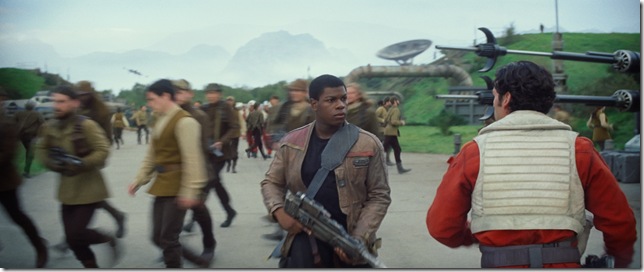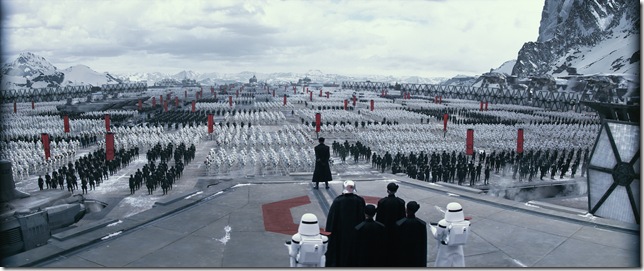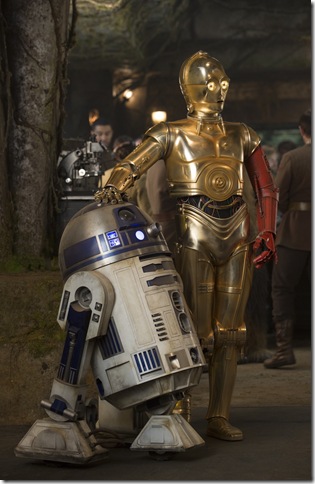Palm Beach ArtsPaper Staff
A mass-market cultural phenomenon is set to take place Dec. 18, with the release of the highly anticipated new Star Wars film The Force Awakens, the first in a new trilogy of the durable space operas, now directed by J.J. Abrams.
While newcomers such as John Boyega and Daisy Ridley are on board, many of the original characters and actors are reprising their roles, including Mark Hamill as Luke Skywalker, Carrie Fisher as Princess Leia and Harrison Ford as Han Solo.
“The ‘Star Wars’ films defined childhood for a generation of adults and has an ongoing appeal to upcoming generations,” says Gerald Sim, associate professor of film studies at Florida Atlantic University and a Star Wars fan.
“The amount of YouTube views for a 30-second trailer shows how highly anticipated the new film is,” he says. As of early December, the official trailer had some 67 million views to its credit.
A film about adventure, good guys vs. the bad guys, moral dilemmas, father-and-son relationships and the struggle for power, all told in a way that touches people’s hearts, the film left an enduring legacy on Hollywood, leaving its mark on such films as Raiders of the Lost Ark, The Matrix, and The Lord of the Rings.
This latest sequel to the Star Wars franchise, which began in 1977 with the first film, simply titled Star Wars, (and later subtitled “Episode IV: A New Hope”) with its groundbreaking special effects, marked the beginning of a three-decade love affair for creator George Lucas and his fantasy-filled films.
The two other films, The Empire Strikes Back and Return of the Jedi, were released in 1980 and 1983, respectively.
A second trilogy comprised of The Phantom Menace, Attack of the Clones, and Revenge of the Sith, which came out between 1999 and 2005, received mixed reviews and many people were disappointed.
“The intensity of reactions, including intense hatred, to the second trilogy speaks to the importance of the film on a whole generation of people,” Sim said.
Despite the controversy, all six films were nominated for or won Academy Awards, and all were box-office hits, earning in excess of $4.38 billion.
One can look at the impact of the Star Wars franchise on popular culture through a number of different lenses: cultural, economic, psychological, historical and religious. Few films have added so much to the cultural vocabulary — from death stars to jedi knights, light sabers to Yoda — and it as much a marketing phenomenon as it is an intergalactic adventure series.
Star Wars: The Force Awakens reportedly cost $400 million to make, and pre-sale tickets broke IMAX records with more than $6.5 million sold for U.S. screenings in the first day.
Opening weekend is projected to bring in more than $215 million with a total domestic gross of $762 million, according to expectations by website BoxOffice.com, as well as a global take of $2 billion to $3 billion.
“With all the millions spent on merchandising and toys, it shows people are invested in the series and can generate billions in merchandising deals even before the first ticket is sold,” Sim said.
As a film historian, Sim prefers to look at the film through the lens of history, and sees an irony in the fact that George Lucas, whose dream was to make art movies, directed one of the most profitable film franchises of all time.
Shelly Isaacs, a film buff and expert on popular culture who runs an international film series called Café Cinematheque, agrees with Sim about the economic impact of the Star Wars films.
“‘Star Wars’ is part of our lifestyle and permeates our culture,” says Isaacs. “Disney [which bought Lucasfilm in 2012] is a master marketer.”
“It’s a money machine for Disney,” says Isaacs, who notes that Disney has plans to open a Star Wars theme park in Florida and California. He also sees the franchise expanding to emerging markets in China and India.
“I remember the excitement of going to see the first ‘Star Wars’ movie,” says Sim, 43, who was in elementary school in 1977. “With each new film we re-live that initial thrill.”
“At the time Lucas used innovative technology to create special effects and establish a set of expectations of what film should look like and how slick special effects should be,” Sim says.
Lucas’s company, Industrial Light & Magic, a division of Lucasfilm, which he founded in 1975, became the industry standard for computer graphics and special effects.
The first Star Wars film launched the careers of Hamill, Ford and Fisher, and raised the profile of its composer, John Williams, who has scored the new film as well as the previous six. Few pieces of music are as familiar to audiences as the fanfare-like opening title of the film, or the menacing march associated with Darth Vader.
Williams’ soundtrack for the original Star Wars film was voted “most memorable film score of all time” by the American Film Institute in 2005.
Sim notes that Princess Leia was a role model for young girls. Rachel Galvin, writer and producer of the online film magazine Independent Streak, remembers dressing up as Princess Leia.
“I identified with her,” says Galvin. “I was the only girl in my class, much like Leia in a universe where there were very few women.”
“Princess Leia is an excellent role model,” says Galvin. “She is less seen as a quintessential sexpot and more as a warrior, kicking butt and taking names, and standing up for herself.
“Although she needs help, she isn’t completely helpless, unlike other films with damsels in distress,” she says.
Galvin also notes that Lucas was a pioneer in using action as a driving force in a story.
“The very way in which the tale was told seemed unique and epic in scale, with high-tech dog fights in space changing the way sci-fi was viewed and paving the way for more films in the future,” Galvin says.
“Of course, it spawned a slew of marketing opportunities and other films in the franchise as well,” she says.
Lucas’ reliance on Jungian archetypes and his interest in the work of anthropologist Joseph Campbell led him in Star Wars to reference Greek and Nordic mythology and synthesize a number of genres, including science fiction, Westerns, soap operas, fantasy and Japanese samurai films.
“Lucas, as part of the New Hollywood, along with Francis Ford Coppola and Steven Spielberg, studied film and grew up watching old Hollywood movies. He has a vast knowledge and vocabulary of old films, and some scenes in his film are a recreation of scenes from earlier films, such as John Ford’s 1956 film, ‘The Searchers,’” says Sim, referencing scenes in Star Wars that take place on the planet Tatooine.
The first film, coming out in a decade emerging from a long and exhausting war in Vietnam and one in which the president of the United States, Richard Nixon, resigned in scandal, heralded the dawn of a new cinematic era.
“It was an age where we could dream and get away,” says Isaacs. “‘Star Wars’ reignited our imaginations. It was exciting and brought a new direction in film. ‘Star Wars’ brought us excitement and brought us back our heroes.”
Isaacs notes that contemporaneous with Star Wars were such films as Martin Scorsese’s Taxi Driver, Coppola’s Apocalypse Now and Dennis Hopper’s Easy Rider — “all gritty films steeped in reality.”
“In contrast, ‘Star Wars’ was steeped in fantasy,” he says.
Local cinephile Dave Montalbano (aka “Cinema Dave”) believes that Star Wars would not be the success that is today if the sequel, The Empire Strikes Back, had not been as good as it was.
“The first sequel reached for something deeper with the introduction of Yoda and his philosophies about The Force,” says Montalbano.
He notes a synchronicity in the release of the The Force Awakens a month after the release of the latest Rocky iteration, Creed, starring Sylvester Stallone in his original role as Rocky Balboa.
“It’s ironic that ‘Creed’ is being released at the same time as the new ‘Star Wars’ movie,” says Montalbano. “The first ‘Star Wars’ was released a few months after the original ‘Rocky’ won the Oscar for best picture.
“Now,” he says, “Rocky is going to be a secondary character in ‘Creed.’ It’s a rite of passage, much like Han, Leia and Luke passing the torch to the new generation.”
As the characters in the new Star Wars film break barriers and explore new galaxies, the legacy of the franchise looks certain to last for years to come.
“We want to imagine ‘Star Wars’ as our future,” says Isaacs. “It’s every child’s dream. It’s a common thread among generations — totally translateable and relateable,” he says.
***
A critic remembers: The first ‘Star Wars’
The time was May of 1977 and, for me at least, the place was the front row of Washington, D.C.’s wraparound screen movie palace, the Uptown, which had the city-wide exclusive rights — by default? — to show an untouted intergalactic swashbuckler by George Lucas, that guy who made the nostalgic teen epic American Graffiti just four years earlier. Called Star Wars, it was set in a galaxy far, far away and had the ability to transport moviegoers back to the days of Buck Rogers, Flash Gordon and other Saturday morning serials.
Thirty-eight years ago is eons when it comes to special effects, but the visuals of Star Wars have a timeless quality. Retro from the start, they were never intended to awe, though they gave birth to one of the movie world’s great effects mills — Industrial Light & Magic. Instead, Lucas put the emphasis on storytelling, concocting a mythic tale of an orphan (or so he thought) named Luke Skywalker and his coming-of-age amid an intergalactic battle between a rebel army and the Empire, with borrowed bits from Westerns, war pictures and adventure tales.
Lucas was never much good at directing actors — for evidence, see Episode I, The Phantom Menace — but in the original films, he had the good sense and taste to cast such classically trained performers as Alec Guinness and James Earl Jones, who knew how to make even the silliest dialogue sound good. True, he also cast Mark Hamill and Carrie Fisher, but that was probably so R2D2 and C3P0 could come off less robotic in comparison.
Nothing, it seems, can really diminish the affection fans have for the original trilogy of Star Wars films, though Episodes I, II and III seemed to try. And as for the imminent follow-up movies, we can only cross our fingers and harbor a new hope. — Hap Erstein



